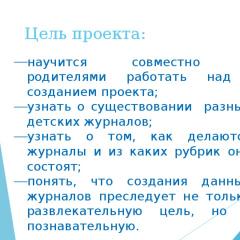Salts of nitric acid. Presentation on the topic "Nitric acid and its salts" Application of Nitric acid
Kirillova
Margarita Alekseevna
Chemistry teacher at Lyceum No. 369
Krasnoselsky district
The nitrogen atom has three unpaired p-electrons on the outer layer, due to which it forms three σ-bonds with oxygen atoms. Due to the lone electron pair, a fourth covalent bond is formed. Electronic cloud
delocalized between
two oxygen atoms.
Valence – IV
Oxidation state -5
Colorless liquid, fuming
in the air.
Acrid smell.
Yellow color concentrated
acids (decomposition to form
NO2). 4HNO3 = 4NO2 + 2H2O + O2
Density 1.52 g/cm3.
Boiling point – 860C.
Solidification temperature - -41.60C.
Hygroscopic.
Mixes with water in any
ratios.
Dilute nitric acid exhibits properties common to all acids:
Dissociation in aqueous solution:
HNO3 → H++ NO3-
Reaction with bases:
NaOH + HNO3 = NaNO3 + H2O
Cu(OH)2 + 2HNO3 = Cu(NO3)2 + 2H2O
Reaction with basic oxides:
CaO + 2HNO3 = Ca(NO3)2 + H2O
Reaction with salts:
Na2CO3 + 2HNO3 = 2NaNO3 + H2O + CO2
Metal oxidation:
Recovery Products
depend on activity
metal and dilution
nitric acid.
HNO3(conc)+ content
II. Nitric acid is a strong oxidizing agent
Al, Fe, Co, Ni, Cr do not interact without heating
HNO3(conc)+ content
K, Ca, Na, Mg, Zn…
K, Ca, Na, Mg, Zn…
4HNO3(conc) + Hg = Hg(NO3)2 + 2NO2 + 2H2O
4Zn + 10HNO3(dil)= 4Zn(NO3)2 + NH4NO3 + 3H2O
3Cu + 8HNO3(dil) = 3Cu(NO3)2 + 2NO + 4H2O
Cu + 4HNO3(conc) = Cu(NO3)2 + 2NO2 + 2H2O
Zn + 4HNO3(conc) = Zn(NO3)2 + 2NO2 + 2H2O
Al + HNO3(conc) =
Fe+ HNO3(conc) =
P + 5HNO3(conc) = H3PO4 + 5NO2 + H2O
Oxidation of non-metals and organic
C + 4HNO3(conc) = 4NO2 + CO2 + 2H2O
Organic substances are oxidized
and ignite in nitric acid.
In industry - oxidation
4NH3 + 5O2 = 4NO + 6H2O
4NO2 + O2 + 2H2O = 4HNO3
In the laboratory - interaction
potassium or sodium nitrate with
concentrated sulfuric acid
when heated:
KNO3 + H2SO4 = HNO3 + KHSO4
Obtained by the interaction of nitric acid with metals, metal oxides, bases,
ammonia and some salts.
Physical properties. These are solid crystalline substances, highly soluble in water.
Chemical properties. Strong electrolytes
exhibit all the properties of salts.
NaNO3 Na+ + NO3-
Cu(NO3)2 + 2KOH = Cu(OH)2↓ + 2KNO3
AgNO3 + NaCl = AgCl↓ + NaNO3
Pb(NO3)2 + Zn = Pb + Zn(NO3)2
Ba(NO3)2 + H2SO4 = BaSO4↓ + 2HNO3
MexOy + NO2 + O2
2KNO3 = 2KNO2 + O2
2Cu(NO3)2 = 2CuO + 4NO2 + O2
2AgNO3 = 2Ag + 2NO2 + O2
Ammonium nitrate decomposition:
NH4NO3 = N2O + 2H2O
NaNO3 + H2SO4 = NaHSO4 + HNO3
4HNO3 + Cu = Cu(NO3)2 + 2NO2 +2H2O
Brown gas
Solid nitrates. A pinch of salt
throw burners into the fire.
There is a bright flash.
dyes
medicines
fertilizers
plastic
pyrotechnics
explosive
substances
HNO3 and nitrates
On the topic: methodological developments, presentations and notes
The lesson has a pronounced practical orientation. Students conduct a chemical experiment, study the properties of nitrates and reveal their practical significance for plants and humans....
1 slide
Salts of nitric acid, application Lesson motto “Au, Na, Ar, Ne, It, Eu – Os, Ra, U, Db, In, Er, As Ni, Es C, Eu La b” L. N. Tolstoy

2 slide
know and be able to name salts of nitric acid, determine what oxidative or reducing properties are characteristic of them; determine: the degree of oxidation of chemical elements in salt formulas; the types of chemical reactions in which they can participate; characterize: general chemical properties of nitric acid salts;

3 slide
Game “Tic-Tac-Toe” A solution of nitric acid reacts with each of the substances. MgO Al P2O5 KCl CO2 CaCO3 Al2O3 K2SiO3 Zn

4 slide
What classes of inorganic substances do these substances belong to? 1. Name the salts - the products of these reactions. 2. Write down the molecular equations for the reactions of producing nitrates in your notebook. MgO Al P2O5 KCl CO2 CaCO3 Al2O3 K2SiO3 Zn

5 slide
Complete the reaction equations and explain which classes of compounds can produce nitrates when interacting. BaO + HNO3 → BaO + N2O5 → Ba(NO3)2 + Na2SO4 →

6 slide
Given pairs of substances, create possible reaction equations: a) sodium hydroxide and nitric acid, b) potassium hydroxide and nitric oxide (V), c) calcium oxide and nitric acid, d) ammonia and nitric acid, e) barium sulfate and calcium nitrate, f) sodium chloride and barium nitrate. Which reactions are impossible and why?

7 slide
List the salts obtained as a result of possible reactions. Potassium, sodium, calcium and ammonium nitrates are called nitrates KNO3 - potassium nitrate (Indian nitrate), NaNO3 - sodium nitrate (Chilean nitrate), Ca(NO3)2 - calcium nitrate (Norwegian nitrate) NH4NO3 - ammonium nitrate (ammonium or ammonium nitrate, there are no deposits of it in nature). German industry is considered the first in the world to produce NH4NO3 salt from nitrogen N2 in air and hydrogen in water, suitable for plant nutrition.

8 slide
Nitrates are solid crystalline substances, refractory, determine from the solubility table which electrolytes they belong to - strong or weak?

Slide 9
Physical properties of nitrates What substances are called salts? It is necessary to build a logical chain: type of chemical bond - type of crystal lattice - interaction forces between particles at lattice nodes - physical properties of substances.

10 slide
Chemical properties of nitrates Interaction of nitrates with metals, acids, alkalis, salts Cu(NO3)2 + Zn..., AgNO3 + HCl..., Cu(NO3)2 + NaOH..., AgNO3 + BaCl2....

11 slide
Interesting story An inquisitive chemist studied the types of chemical reactions and noticed that insoluble carbonates (CaCO3), sulfites (CaSO3), silicates (CaSiO3), some sulfates (FeSO4) decompose when heated. He set himself the task of determining whether nitrates would decompose. For the experiment, he took a laboratory stand, a test tube with sodium nitrate, and an alcohol lamp. Knowing that the decomposition of many salts produces gas, the inquisitive chemist prepared a torch, litmus paper and lime water (Ca(OH)2). When the salt heated up and melted, he lowered a smoldering splinter into the test tube, it suddenly flared up. What conclusions did the young chemist come to?

12 slide

To use presentation previews, create a Google account and log in to it: https://accounts.google.com
Slide captions:
Lesson on the topic “Nitric acid” 9th grade Chemistry teacher: Matyushkina T.S.
In the lesson we will: -continue to study nitrogen compounds -look in detail at the properties of HNO 3 -we will improve our skills in writing reaction equations -learn about the areas of practical application of HNO 3 and its salts
Chemical warm-up: 1. Formula of ammonia: a) NH 2 b) NH 4 c) NH 3 d) N 2 2. Ammonia: a) lighter than air, b) heavier than air, c) neither lighter nor heavier 3. Ammonia is: a) an oxidizing agent, b) a reducing agent, c) both. 4. Ammonium ion a) NH 2 + b) NH 4 + c) NH 3 – d) NH 3 5. The electron donor during the formation of the ammonium ion is a) nitrogen atom, b) hydrogen ion, c) ammonium ion 6. Oxidation state nitrogen in ammonia: a)0, b)-3, 4)+3, 5)8
Chemical warm-up Determine the oxidation state of nitrogen in each oxide
Nitric acid HNO 3 is one of the most powerful acids. Physical properties: - colorless liquid - “smoke” in air, boiling point = 84 o C, t pl = -42 o C - turns yellow in light due to the release of NO 2: 4HNO 3 =2H 2 O +4NO 2 + O 2
Obtaining HNO 3
Chemical properties Typical properties of acids
Chemical properties Reacts particularly with metals:
Chemical properties: Interaction with non-metals
For the curious:
Application of HNO 3 salts - in agriculture - for dyeing fabrics - in medicine - in pyrotechnics
Check yourself: The degree of oxidation of nitrogen in HNO 3 a) -3 b)0 c)+5 d)+4 When stored in the light, HNO 3 a) turns red b) turns yellow c) remains colorless Nitric acid is: a) an oxidizing agent, b) reducing agent, c) both. Does HNO 3 exhibit properties common to other acids? a) yes b) no c) depends on the weather Aqua regia is a) concentrated alcohol b) 3 volumes of HCl and 1 volume of HNO 3 c) concentrated nitric acid
Complete the sentences: -today in class I learned... -I practiced... -I saw...
Homework: Learn the theory: pp. 118-121 Exercises 2, 3,4 p. 121
On the topic: methodological developments, presentations and notes
Klochkova Violetta Mikhailovna, chemistry teacher, Secondary School No. 2 named after I. I. Tarasenko senior Settlements of the Krasnodar Territory....
Summary of a combined lesson on the topic "Nitric acid". This lesson discusses the physical, general and specific properties, laboratory and industrial methods for producing nitric acid...
To use presentation previews, create a Google account and log in to it: https://accounts.google.com
Slide captions:
and not one vessel can hold more than its capacity, except the vessel of knowledge; it is constantly expanding. Arabic proverb
This substance is called “Chinese snow” in Europe; in 808, the Chinese alchemist Qin invented black gunpowder based on it. Determine the molecular formula of a substance if it contains 38.61% potassium, 13.86% nitrogen and oxygen.
Nitric acid salts
Nomenclature of salts Nitrates: Ba (NO₃)₂ , AgNO ₃ , Zn(NO₃)₂ , NaNO ₃ Nitrates: NaNO ₃ , KNO₃ , Ca(NO₃)₂ , NH₄NO₃
Structure and physical properties of nitrates Type of chemical bond - ionic Type of crystal lattice - ionic State of aggregation - solid crystalline substances Solubility in water - most soluble
Chemical properties common to other salts Electrolytes Reactions with acids Ba (NO₃)₂ + H₂SO₄ with alkalis Fe(NO₃)₃ + NaOH with salts AgNO ₃ + BaCl ₂ with metals Cu(NO₃)₂ + Fe
Special properties of nitrates Thermal decomposition Without wasting time, let's figure out how nitrates decompose in the stove. What happens? The alkali metal is so active, He says in a commanding tone: “Being a nitrate is so disgusting. I’d rather turn into nitrite!” And metals from the company from magnesium to copper, Zinc, iron and their other neighbors Carefully and calmly, without offense, their oxide is extracted from nitrate. Well, what about silver and mercury? Metals that consider themselves noble wish to become completely, completely free.
Special properties of nitrates Qualitative reaction to NO₃⁻ NaNO ₃ + Cu + H₂SO₄
Nitrates: pros and cons
Name of plant Recommendations for use Patisson It is better to cut off the upper part adjacent to the stalk Cucumber Peel the cucumber and cut off the tail Cabbage Remove the upper covering leaves and throw away the stalk Zucchini Cut off the skin Beets Cut off the upper and lower parts of the root vegetable Potatoes Pour 1% water over the peeled potatoes for a day table salt or ascorbic acid Carrots Cut off the top and bottom of the root vegetable Table. Accumulation of nitrates in various parts of plant productive organs.
On the topic: methodological developments, presentations and notes
This lesson is discussed first in the “Computer Presentations” section. In this lesson, students become familiar with the POWERPOINT program, learn how to change the design and layout of slides....
Presentation "Use of multimedia presentations as a universal means of cognition"
The presentation “Using multimedia presentations as a universal means of cognition” provides advice on the design and content of presentations....
Development of a lesson and presentation "The Sightseeng Tours" London and Saint-Petersburg with presentation
Goals: development of speech skills (monologue statement); improving grammatical reading and speaking skills (past indefinite tense, definite article) Objectives: teach...
Presentation "Recommendations for creating multimedia presentations"



